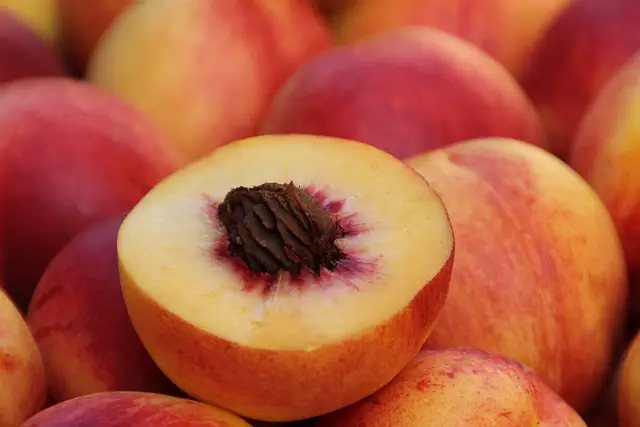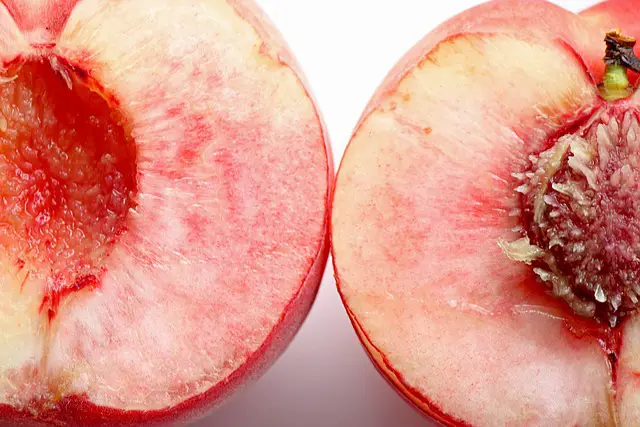
I’m sure it’s happened to all of us – you cut into a perfect-looking, juicy peach, only to find that the pit inside has split in half or shattered into small pieces. What happened? Is the peach still ok to eat? I’m always looking for solutions to these types of fruit-growing problems in my garden. Is there any way to prevent split pits in peaches?
Peach pit splitting happens due to excessive watering, fertilizing, or thinning. The peaches grow too quickly, causing the expanding flesh to pull on the pit and crack it open. Avoid extra watering or fertilizing in the weeks prior to harvest, and avoid over-thinning the young fruit.
Split pits are a common problem for peach growers, and sometimes the cause is out of the gardener’s control (hello, droughts and heavy rains). But, there are a few things you can do to minimize the likelihood of this happening. Let’s look at what causes pit splitting, and what a gardener can do to prevent it.
What is Pit Splitting, and What Causes It?
Pit splitting is where the stone (or pit) in the center of a ripened fruit is not whole, but is instead cracked, split, or even shattered into pieces when the fruit is cut open. This can happen to any type of stone fruit, such as peaches, nectarines, plums, and apricots.
There are a lot of things that can exacerbate peach pit splitting, but the actual cause remains a bit of a mystery. Some sources suggest that low temperatures or frost damage during flowering may factor in. But primarily, splitting happens during fruit swell when the peach is quickly increasing in size in the weeks leading up to harvest. Splitting is more common in early-ripening peach varieties, which are more susceptible because fruit swell begins before the pits have fully hardened.
When something causes the peaches to grow too rapidly, then the flesh attached to the stone will exert excessive force, splitting the pit open. Splitting is a little more common in clingstone peaches for this reason, because the flesh is more firmly attached to the pit.
Rapid growth can be caused by poor cultural practices, such as overwatering or over-fertilizing (especially with a high-nitrogen fertilizer). Overwatering (either by the gardener or by rainfall) during fruit swell will cause the peaches to enlarge too quickly. Similarly, over-fertilization stimulates unnaturally quick growth, causing pit splitting.
Although peach thinning is generally a good practice (read Should I Thin the Fruit on My Peach Tree? for reasons why), over-thinning can also cause peach pits to split. A late frost or bad spring storm may cause blossoms or young fruits to fall. If you (or Mother Nature) drastically reduce the tree’s fruit load, the remaining peaches may grow too quickly, causing pit cracking or splits.
How Do You Prevent Peach Pits from Splitting?
First, get to know your peach cultivar. If you’ve noticed in the past that your peach variety seems prone to splitting, try doing less fruit thinning – perhaps only remove diseased or damaged fruits that could invite pests or spread infection.
If this still doesn’t help, consider planting a cultivar that ripens later, or that is resistant to splitting. Some good split-resistant options include ‘Flamin’ Fury’, ‘Garnet Beauty’, and ‘Redstar.’

Limit extra irrigation or fertilizing in the few weeks leading up to harvest. At most, water a peach tree deeply every week or two, depending on rainfall and temperature. An excessive dry spell followed by a heavy rain will most likely cause peaches to split. It’s one of those things that sometimes happens, but you may still be able to use most of your harvest, and it shouldn’t affect next year’s crop.
Good cultural practices, such as a well-drained planting site, mulching, and annual moderate pruning can help prevent peach splitting. For more information on how to prune your backyard peach tree, check out A Simple Guide to Pruning Peach Trees for Maximum Harvest.
How To Tell if a Peach Has a Split Pit
A peach with a split pit may look normal until it is cut. The pit in the center will be cracked, split in half, or shattered into small pieces. Often there is a visible opening on the stem end of the fruit. The peach may also be slightly flattened on the bottom.
A peach with a split pit may enlarge and ripen quicker than other peaches on the tree. Keep an eye on the ripening peaches; if any have visible openings close to the stem, you may want to pick them early to prevent pest issues or rotting.
Is it Safe to Eat a Peach with a Split Pit?
A peach with a split or cracked pit is probably safe to eat, especially if there is no visible opening at the stem end of the fruit. If there is any noticeable pest damage, rotten flesh, or fuzzy mold inside the pit, then it is better to avoid eating the peach.
A crack or opening at the end of the peach that connected to the stem could invite pests, infection, or rot. Check an open peach carefully for signs of these issues. If the flesh looks good and there is no mold present, then it is most likely safe to eat. If necessary, cut off any small areas of damaged flesh.
Speaking of mold: the firm, whiteish flesh that is sometimes found around the pit (even occasionally in non-split peaches) is not mold. It’s called callus tissue, and the peach essentially manufactured it to try to repair the broken split pit. The callus tissue is ok to eat – it doesn’t have the soft, “peachy” flavor, but it is still sweet and slightly crunchy.
Mold will probably be concentrated inside of the split pit around the kernel that is in the center. It looks like white fuzz, and it may have a gooey appearance. When in doubt, if you see mold, avoid eating the peach.

